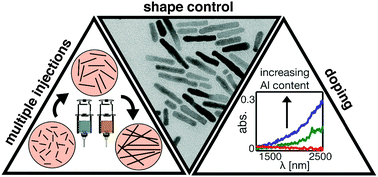Modular synthetic design enables precise control of shape and doping in colloidal zinc oxide nanorods†
Abstract
Zinc oxide (ZnO) is a wide-band gap II–VI semiconductor with various optoelectronic applications owing to its transparency to visible light and tunable optical/electronic properties achieved by doping. While exquisite morphology control has been demonstrated for colloidal cadmium-chalcogenide II–VI nanocrystals over the past two decades, shape control strategies for solution-grown anisotropic ZnO nanocrystals (<100 nm) are limited in scope – they suffer from large polydispersities and highly branched nanorods. Here, we present a modular synthetic design approach that overcomes many of the synthetic challenges associated with zinc oxide nanorods and enables nearly independent control of morphology and impurity incorporation. Manipulation of alcoholysis reaction kinetics through multiple precursor solution injections and judicious use of phosphonic acid surfactants enables the synthesis of nanorods with highly tunable shapes, lengths (40–200 nm), diameters (6–80 nm), and doping levels (with aluminum – Al3+ – cations). This work will enable further studies on shape-dependent phenomena in colloidal metal oxide nanorods as well as facilitate understanding of doping and plasmonics in anisotropic nanoscale metal oxide systems.



 Please wait while we load your content...
Please wait while we load your content...